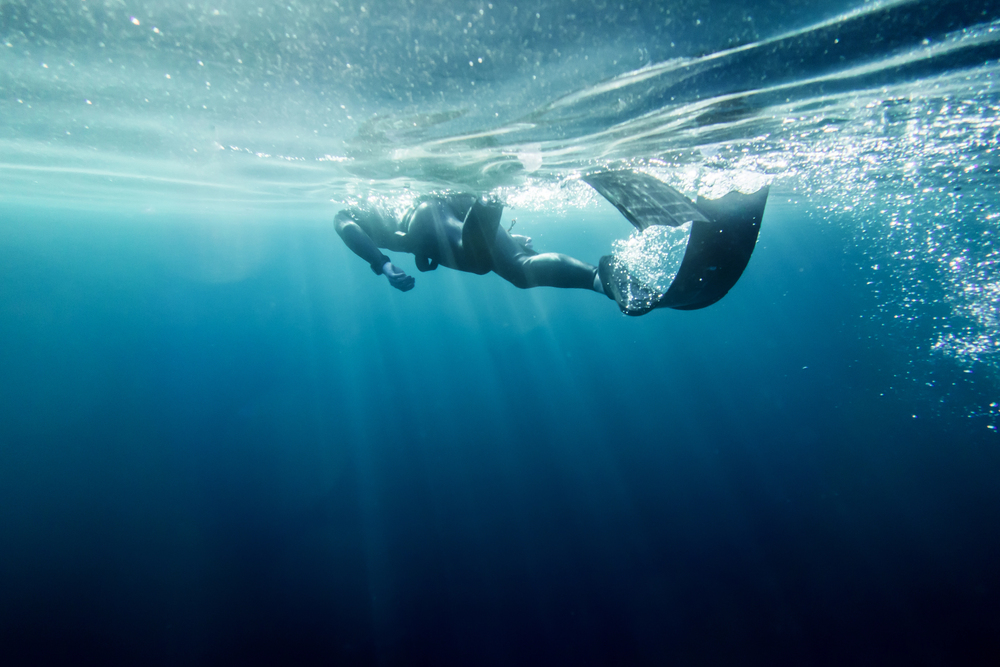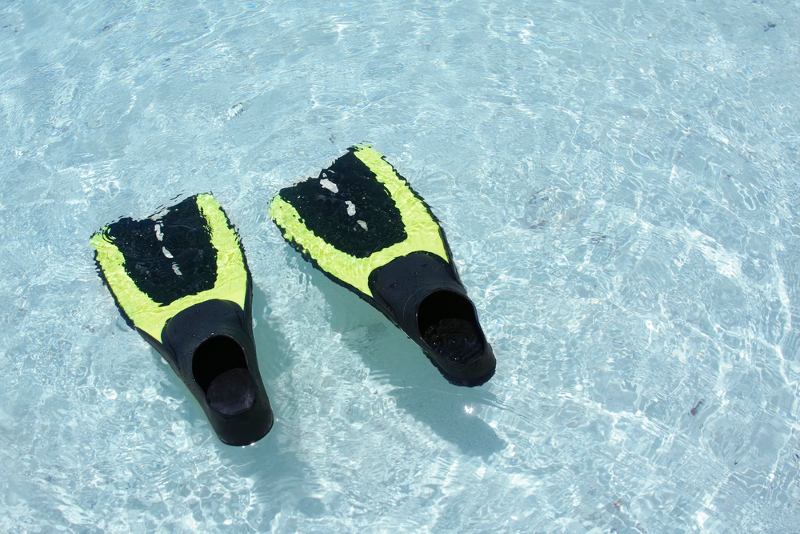Choosing between diving fins for scuba or freediving is an important decision for anyone interested in exploring underwater. Each type of fin is designed for different activities and needs. Scuba fins are built for durability and power, while freediving fins focus on streamlined efficiency. Knowing these differences is essential for achieving good performance and ensuring comfort and safety while diving, as selecting the wrong type can affect your overall experience underwater.
Key Takeaways
- Freediving fins feature longer blades (up to 3.5 feet) compared to scuba fins (1.5-2 feet), which helps enhance propulsion and conserve oxygen.
- Scuba fins have wider, more flexible blades that aid in maneuvering in tight spots, while freediving fins are narrower and stiffer.
- Typically, freediving fins are crafted from lightweight materials like carbon fiber, whereas scuba fins are made from sturdy thermoplastics for durability.
- Scuba fins provide better control for slow movements and swimming backward, while freediving fins are designed for quick, powerful forward thrust.
- Freediving fins convert 15-20% more energy into forward motion than scuba fins but need more space to turn and navigate.
Design and Construction
The design differences between scuba and freediving fins are based on their specific underwater uses. Scuba fins usually have shorter, wider blades with medium stiffness, helping divers move steadily while carrying gear. They often include features like channels or vents to minimize drag and enhance efficiency during extended dives with moderate kicking.
Freediving fins, however, have much longer blades, sometimes twice as long as scuba fins, and are made from stiffer materials like carbon fiber or fiberglass. This design allows freedivers to achieve strong propulsion with minimal leg movement, helping to conserve oxygen during breath-hold dives. The angle of the blade in relation to the foot pocket is also important, with freediving fins typically having a more pronounced upward angle to improve power transfer during the dolphin kick technique.
Both fin types generally use full-foot designs, though scuba fins may include adjustable straps for use with neoprene boots. Material choices differ based on their use, with scuba fins often made from durable thermoplastics and freediving fins focusing on lightweight, high-performance materials.

Blade Length and Width
Blade dimensions are a key difference between freediving and scuba fins. Freediving fins usually have longer, narrower blades that can reach up to 3.5 feet. This design allows divers to achieve strong propulsion while using less oxygen, enabling efficient, slow-frequency kicks for greater distance per kick cycle.
In contrast, scuba diving fins tend to have shorter, wider blades, typically ranging from 1.5 to 2 feet in length. This structure supports the unique needs of scuba divers, who need to navigate with tanks and gear while maintaining control in various underwater environments. The wider blade surface helps distribute the extra force required to move both the diver and their equipment through the water.
The blade width also varies significantly. Freediving fins have a narrower profile, which minimizes drag and promotes streamlined movement. Scuba fins, however, feature a broader blade surface that enhances stability and maneuverability, essential for divers who need to navigate tight areas or maintain specific positions underwater.
Material Composition
Material selection is a key difference between freediving and scuba fins. Freediving fins are usually made from lightweight materials like polymer composites, carbon fiber, or fiberglass, which offer good responsiveness and efficient energy transfer. These materials help freedivers move quickly with less effort, aiding in oxygen conservation during deep dives.
In contrast, scuba fins typically use durable thermoplastic materials such as polypropylene or rubber. These materials are designed for longevity and can withstand the wear and tear from regular use, rocky entries, and boat conditions. The focus for scuba fins is on reliability and consistent performance, as air consumption is not as critical due to tank support.
Recent manufacturing advancements have led to hybrid materials in both types of fins, blending different compounds to enhance performance. For example, some scuba fins use softer rubber in high-stress areas while keeping rigid polymer blades, while premium freediving fins may incorporate carbon fiber strips within polymer structures to optimize flex patterns while managing production costs.

Power Transfer Efficiency
Power transfer efficiency is a key difference between freediving and scuba fins. Freediving fins are designed to enhance energy transfer from the legs to forward movement, featuring longer, stiffer blades that focus power more effectively during each kick. This design enables freedivers to travel further with less oxygen, which is important when diving on a single breath.
In contrast, scuba fins use a more balanced power transfer approach, with shorter, more flexible blades that emphasize ease of movement and prolonged use rather than sheer efficiency. This design meets the needs of scuba divers, who require reliable performance over longer durations while managing heavier gear. Freediving fins typically have a steeper blade angle, which optimizes thrust per kick.
These efficiency variations influence the overall diving experience, with freediving fins converting about 15-20% more energy into forward motion than standard scuba fins. This enhanced efficiency allows freedivers to reach greater depths and distances while conserving oxygen effectively.
Underwater Maneuverability
The two types of fins have notable differences in underwater maneuverability. Scuba fins, built for longer dives with heavy gear, generally allow for better control during slow movements, while freediving fins are designed for quick turns and agility.
Key differences in maneuverability include:
- Scuba fins have shorter blades that facilitate tight turns in limited spaces, making them suitable for exploring reefs and wrecks.
- Freediving fins offer enhanced lateral movement due to their longer, more flexible design.
- Split-fin designs reduce strain on the ankles during long dives while still providing good steering control.
- The longer blades of freediving fins need more room for turns but allow for quicker directional changes when swimming fast.
- Scuba fins are better for swimming backward, which is important for certain technical dive situations.
Choosing between these fin types can significantly affect a diver’s ability to navigate underwater. Scuba divers tend to favor control and stability, while freedivers look for quick, efficient movements that suit their dynamic swimming style and shorter bottom times.
Energy Conservation Properties
Both scuba and freediving fins have unique energy conservation properties that influence a swimmer’s endurance and efficiency underwater. Freediving fins, with their longer and more flexible blades, enable swimmers to create strong propulsion through slow, controlled kicks. This approach helps preserve oxygen and energy, allowing freedivers to travel further while managing their breath effectively.
In contrast, scuba fins have shorter, stiffer blades designed for steady energy output over longer periods. Their design supports a higher kick frequency with less effort per kick, which is beneficial for divers carrying gear and needing to stay submerged for extended times. The moderate blade length ensures a balanced energy transfer, reducing muscle fatigue while providing reliable propulsion.
The energy efficiency of each fin type is tailored to its intended activity: freediving fins focus on maximizing output per kick to conserve oxygen, while scuba fins evenly distribute energy use across multiple kicks. This difference allows divers to choose fins that suit their specific underwater goals and breathing needs.
Travel and Storage Considerations
When planning underwater adventures, it’s important to consider how scuba and freediving fins affect luggage space and transport. Their design influences portability and storage, so understanding their differences is essential for travel arrangements.
Key travel and storage considerations include:
- Scuba fins often take up more space due to their stiff build and larger foot pockets, which may require specific gear bags.
- Freediving fins, especially those with detachable blades, can be taken apart for more compact storage and easier transport.
- Airlines may have restrictions on fin lengths, making shorter scuba fins or separable freediving fins more suitable for air travel.
- Freediving blades made of composite materials need careful handling to avoid warping from temperature changes.
- Both fin types should be stored in protective sleeves or cases to prevent damage during travel.
The weight difference between these fins also affects travel logistics. Traditional scuba fins are usually heavier than freediving ones, which is important to consider regarding airline baggage weight limits and when planning trips that involve multiple gear transfers.
Price Point Comparisons
Analyzing the costs of scuba and freediving fins shows notable price differences based on materials and intended use. Entry-level scuba fins are generally priced higher than basic freediving fins, while top-tier models for both activities can become quite expensive with advanced materials and design.
| Price Category | Scuba Fins | Freediving Fins | Common Features |
|---|---|---|---|
| Entry-Level | $50-100 | $40-80 | Basic plastic construction |
| Mid-Range | $100-200 | $80-150 | Reinforced materials |
| Professional | $200-300 | $150-250 | Carbon fiber elements |
| Premium | $300-500 | $250-400 | Full carbon construction |
| Custom | $500+ | $400+ | Tailored fit, materials |
When selecting fins, it’s worth noting that professional-grade freediving fins often provide better value due to their versatility. The price gap widens in the premium category, as scuba fins may include features like quick-release buckles and specialized blade designs. For those on a budget, mid-range options in both categories usually offer a good balance of durability and performance.
Maintenance Requirements
The maintenance needs for scuba and freediving fins vary in complexity and frequency. Both types require basic care, but knowing their specific maintenance requirements can help extend their lifespan and ensure good performance during water activities.
For both types of fins, follow these essential maintenance practices:
- Rinse thoroughly with fresh water after each use, focusing on buckles and straps to prevent salt buildup.
- Store fins in a cool, dry place away from direct sunlight to avoid material damage and color fading.
- Regularly check foot pockets and blades for signs of wear, cracks, or detachment.
- Clean with a mild soap solution quarterly, steering clear of harsh chemicals that could weaken the materials.
- Use protective cases or bags when transporting fins to avoid damage from impacts or scratches.
Freediving fins require more careful handling due to their longer, more delicate blades, while scuba fins are generally sturdier. Regular maintenance helps prevent material degradation, especially in the foot pocket areas where wear is most common. Proper care ensures consistent performance and reduces the risk of equipment issues underwater.


